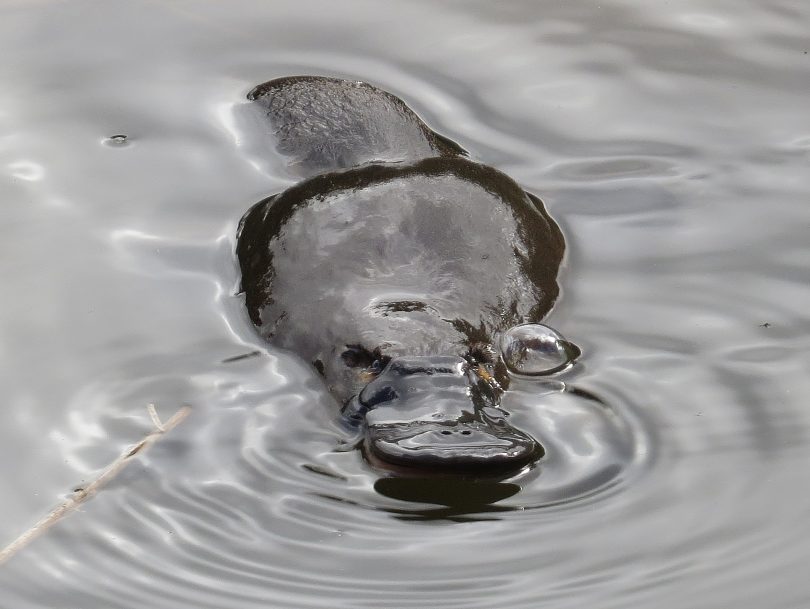
Platypus numbers have declined due to human impact on their environment, irresponsible fishing activities and predation. Photo: Supplied.
Although platypus, our beloved and elusive monotreme, are listed as near-threatened, Victorian Platypus Conservancy biologist Geoff Williams says that if you’ve been near a creek or river lately, chances are you’ve been standing next to a platypus and didn’t know it.
“There are platypus in all the rivers around you – the Bega river, the Bombala river,” Geoff says, “it’s just that most people don’t know how to spot them.”
But teaching regular folks how to spot platypus and record their sitings in a widespread citizen science project is a huge part of Geoff’s job in Victoria – and he has his sights set on our region next.
According to Geoff, biologists have had a hard time getting a handle on how many platypuses there are in any one area – and even PhD students aren’t keen to tackle a platypus study once they realize what it involves and consider that male platypus have a poisonous spur.
“There are two things that make platypus hard to study – the first thing is that they are mostly nocturnal and the second thing is that they spend most of their time underwater so even when they are out in the day, they aren’t necessarily very visible,” Geoff explains.
Added to these hurdles is the lack of evidence platypus leave in their environment – “they defecate in the water, so no scat is visible, they leave no tracks and they don’t vocalise.”

A platypus surfaces for 10-15 seconds before diving again, creating a tell-tale ripple pattern on the surface of the water that is unmissable once you know what you’re looking for. Photo: John Burndock.
In Cooma, Waterwatch coordinator Antia Brademann says that while it’s commonly understood that platypus numbers are declining, according to historical evidence and anecdotal reports, the fact is that there is still so much we don’t know about these iconic Australian animals.
“That’s why the water watch work is so important – mostly we look at macroinvertebrates, or waterbugs, and because they tell us so much about the quality of waterways and are the main food source for platypus, that data helps us see how platypus are doing.”
All along the upper Murrumbidgee, there are signs that platypus populations are stressed, Antia says.
“Unexpected sightings tell us that young males are having to go further to find suitable food sources and territory,” Antia explains. “Last year, when it was really dry, we had someone film a platypus in Lake Tuggeranong. These sightings are a sign that populations are working harder across their range.”
As well as the compromised health of their waterway homes, platypus are threatened by foxes, who prey on juveniles, litter and irresponsible fishing activities, Geoff says.

A platypus who died after becoming tangled in fishing line at Werribee. Photo: Supplied.
Chief among those fishing activities is yabby trapping, an activity which has been banned in Victoria beginning 1st July of this year due to the traps accidentally killing so many platypus and Rakali [native water rats].
“Most people out there fishing are responsible and check their traps and clean up after themselves,” Geoff says, “but it only takes one abandoned trap …we’ve found up to seven dead platypus in one trap. The traps cost about five bucks and there’s no obligation by the retailer to educate about how to use them.”
Upper Murrumbidgee Waterwatch Facilitator Woo O’Reilly says that in the absence of standardized monitoring, the citizen science projects being rolled out by Waterwatch and the Platypus Conservancy are providing a wealth of valuable data.
“We’re finding that it’s so valuable to have someone stand in the same spot by the same river for five minutes and scan the water,’ she says.
Every August, Woo and her colleagues organize a widespread platypus survey.
“August is a time when the animals are usually much more conspicuous as they enter their breeding period and have to forage more widely because of low waterbug numbers at that time of year,” Woo explains.
January and February are also good times to spot platypus as the young are coming out of their burrows.
Geoff, Woo and Atia are all concerned about the future of the platypus.
“Things have to be pretty bad for a species to qualify for conservation funding but it’s a shame because it’s so much harder to pull things back from the brink than to protect them at this stage,” Woo says.
To get involved with monitoring platypus through citizen science programs, please visit ACT Waterwatch or The Australian Platypus Conservancy.
Original Article published by Elka Wood on About Regional.














